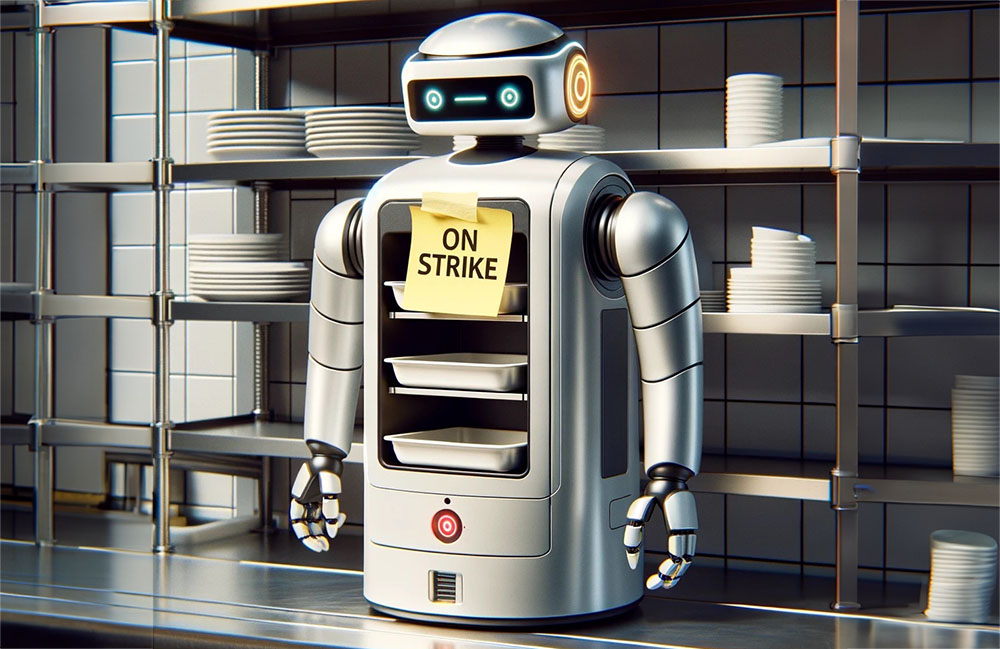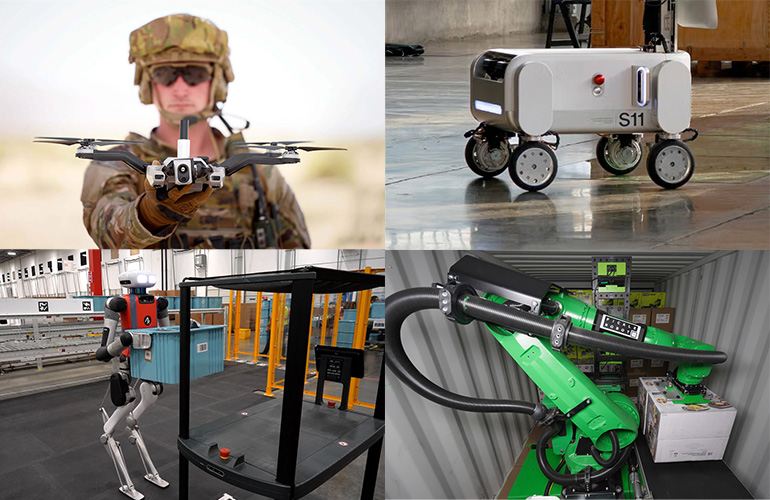Automation requires buy-in and maintenance in addition to service-level agreements, or SLAs, says Roboworx. Source: Dale Walsh, Dall-E
Every robot original equipment manufacturer (OEM), integrator, or reseller dreads the moment when they revisit a customer site only to find that the robot they installed has been gathering dust in a corner for months. When they ask why, responses often follow these lines:
- “It wasn’t working as well as we hoped.”
- “The employees who were trained on it left, so no one knew how to use it or fix it.”
- “Our environment changed but we didn’t know how to reprogram it.”
Whatever the reason, that customer is unlikely to buy more robots anytime soon. And even though many robot vendors offer service-level agreements (SLAs) to help ensure that installed robots stay up and running, SLAs are unlikely to have helped in these situations. The result is a discouraged and dissatisfied customer and a vendor who just took a hit in potential repeat revenue and brand loyalty.
As robotic applications proliferate in industries from manufacturing to hospitality and everything in between, the question for any new or established robot provider is: What does it take to win?
The answer is clear. As any technology grows along the adoption curve, the element that consistently decides winners and losers is the customer experience. With robotics, that’s become both a challenge and an opportunity.
SLAs are important, but they’re not enough
Robots are sophisticated machines. Like cars, they need preventive and scheduled maintenance as well as software updates to continue to work at their peak.
Robot SLAs have become more common to address issues related to diagnostics and maintenance. Unfortunately, many robot OEMs, resellers, and integrators simply don’t have the resources to offer SLAs to every customer. And even those who rely on SLAs can leave customers unsatisfied.
The problem is that the vast majority of failed robotic installations have little to do with mechanical issues. They’re far more likely to be the result of process-related issues such as robot configuration, out-of-date software or programming, incorrect or out-of-date mapping, or lack of training/retraining.
Alone, any of these issues causes frustration and inefficiencies. Combined, they lead to the robot’s death by a thousand cuts.
This is especially true in industries where the use of service robots is seeing tremendous growth, such as restaurants, hotels, casinos, healthcare, and senior living facilities. In many cases, the robot OEM, reseller, or integrator’s lack of familiarity with the workings of a commercial kitchen or hotel lobby can result in inefficient robot programming and deployment that requires frustrating workarounds by employees.
Even more problematic, these industries are characterized by dynamic environments and entry-level employees with high turnover. The robot may be installed correctly and current workers trained, but it doesn’t take long for the robot to be used in ways it wasn’t designed for.
Employees usually don’t have robotic experience, and the management team that deployed the robots isn’t involved in their day-to-day operations or problem-solving. Employees may change the robot’s environment (moving furniture or equipment) without understanding the impact on the robot’s programming or mapping.
Staffers may not understand payload limits, or cleaning and maintenance restrictions. And if there’s a failure, they’re unlikely to know whether the fix is a simple firmware update that can solve the problem in minutes or something they caused, so they may not tell their manager for fear of repercussions.
Manage robots like employees
Robots – like employees – succeed when they’re managed expertly and appropriately. Companies don’t hire workers and expect them to add value to the business long-term based solely on their health. Valued workers are trained, mentored, developed, promoted, and given opportunities to add value in new, creative ways.
Companies budget for these efforts because they pay for themselves over time. Similarly, it takes more than just SLAs that are designed to keep a robot “healthy” for the robot to pay for itself and continue to add value to the organization.
Robots’ human colleagues also have an important role to play, and the OEM, reseller, or integrator needs to understand the human-robot interaction in the specific application to help both become more successful.
Managing robots depends on a deep robot technology background, application-level expertise, and the ability to connect with and train employees. But building those skills requires time and resources that many robot providers can’t afford.
In order to cost-effectively provide a complete and satisfying customer experience, many robot vendors are looking to outsource this expertise. And they’re helping customers understand the value and return on investment of these services.
5 ways to ensure the best result from a robot investment
Success in robot deployment and scale comes down to five basic elements:
- Expert installation and integration
- Effective initial training and regular retraining of the robot’s human counterparts
- Ongoing adaptation of the robot to an ever-changing environment
- Consistent preventive and routine maintenance
- Collaborate with users on site to determine new and innovative ways to use current robot deployments
The capabilities of any robot provider in each of these elements can range from strong to non-existent. While robot vendors have expertise in their robots and their installation, those organizations often don’t have application-level experience that they can use to anticipate on-site opportunities and potential issues.
Even if those capabilities exist, they may only be available in certain geographies or timeframes. And in-house diagnostic and maintenance resources are overhead that many organizations can’t afford.
For both new and established robot providers, outsourcing the deployment, service, and lifetime optimization of robot fleets can help them win the customer-experience battle without a huge upfront and ongoing investment. An outsourced robot success partner proactively addresses customer needs. That ensures that the robot is professionally managed to do what it was initially intended and that the robot is adapted and refined over time to continue to build value for the customer.
As an example, a robot OEM with a fleet of robots deployed across the country was unable to provide preventative maintenance services, so was only providing reactive or on-demand support. After several months of outsourcing preventive maintenance and customer-success visits to a strategic partner whose only focus is robot success, the OEM’s reactive service calls dropped by 93%.
Because of the success of this program, the OEM now includes these services as standard instead of an option. Customers are highly satisfied with their robot investments, and the manufacturer gains a huge boost in brand loyalty and repeat sales without having to make a significant investment in building a national support network.
Questions for OEMs, resellers, and integrators – as well as customers
Ask yourself these tough questions to ensure long-term successful robot implementations:
- Can I ensure the robots are consistent and reliable in their operation over their lifetime?
- Can I ensure that the robots are integrated into the associated business ecosystems?
- Do I have in-house expertise in the intended application to anticipate challenges as well as opportunities for the robot to add new value?
- Can I provide continuous “best practices” training to help employees make the best use of the investment?
- Can I provide local, expert, and consistent 24/7 support in every region where I have robots deployed?
- Can I ensure that support technicians have robot and application expertise, rather than generic technicians who repair a variety of technologies and may only see a robot occasionally?
- Do I have systems in place to monitor robots, respond immediately to issues, and provide performance dashboards for management?
- Can I ensure that technicians provide a true customer success experience instead of simply performing preventive maintenance or repair?
Robots that don’t meet these deliverables often end up as another failed experiment, pushed into a corner and forgotten. Robots succeed when they are managed.
Robotics OEMs, resellers, and integrators must consider how they will provide this scope that goes beyond SLAs to ensure customer success and satisfaction. And customers need to ask their robot provider how they will accomplish that as well.
 About the author
About the author
Dale Walsh is the vice president of strategy and innovation at Roboworx. His expertise includes robotics, commercial drones, print services, mail & package services, digital mail, intelligent lockers, and other automation technologies. The company helps OEMs and integrators manage their robotic fleet with implementation, break/fix support, and customer success.

 3 months ago
53
3 months ago
53










 English (US) ·
English (US) ·